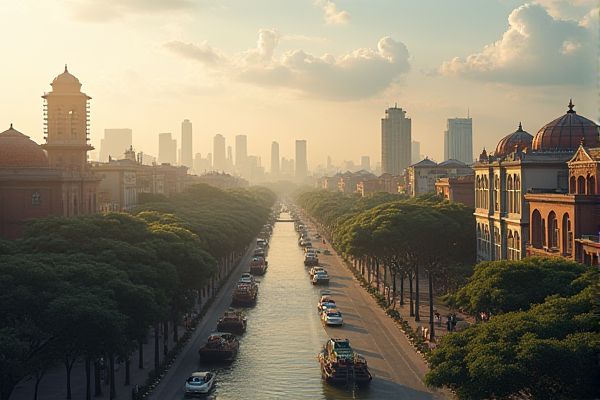
Internet and telecommunications options in India: Major providers: Jio, Airtel, Vodafone Idea. Broadband and fiber connections available. Mobile data plans widely popular. 4G LTE prevalent; 5G emerging. Prepaid and postpaid plans offered. Internet cafes in urban areas. Telecom Regulatory Authority oversees standards. SIM card registration required. Wi-Fi hotspots in public places available. Regional coverage varies significantly.
Major providers: Jio, Airtel, Vodafone Idea.
In India, the major telecommunications and internet service providers are Reliance Jio, Bharti Airtel, and Vodafone Idea. As of 30 September 2023, Jio leads with a dominating 50.98% of the wireless broadband market, followed by Airtel with 30.63%, and Vodafone Idea with 15.57%. The competition between these providers has significantly impacted the digital landscape, providing robust options for consumers across the nation. For more detailed insights into this thriving sector, visit the comprehensive article on the Internet in India.
Broadband and fiber connections available.
In India, broadband and fiber connections are offered by several providers, with BSNL's Bharat Fiber (FTTH) being a prominent option, providing high-speed broadband from 2 Mbps to 300 Mbps, IPTV, voice telephony, and other advanced services like video conferencing and VPN. Other top providers include Jio Fiber, Airtel Broadband, Excitel, and ACT Fibernet, each offering various plans with high speeds and extensive network coverage.
Mobile data plans widely popular.
In India, popular mobile data plans are offered by providers like Jio, Airtel, Vi, and BSNL, featuring various validity options and data limits, including Unlimited Data Plans with daily caps, such as 2GB or 2.5GB per day, along with unlimited voice calls and SMS.
4G LTE prevalent; 5G emerging.
In India, 4G LTE has been highly prevalent, credited with introducing a vast majority of Indians to the internet, particularly after Reliance Jio's disruptive launch in 2016. However, 5G services, launched by Reliance Jio and Bharti Airtel in October 2022, are slowly gaining traction, though their uptake is slower compared to 4G's initial growth due to high 5G smartphone costs and ongoing monetization challenges for telcos.
Prepaid and postpaid plans offered.
In India, telecom providers like Reliance Jio, Bharti Airtel, and Vodafone Idea have introduced new prepaid and postpaid plans following a recent tariff hike of 10-25%. The plans vary in data limits, validity, and additional benefits such as unlimited calling, SMS, and OTT subscriptions, with effective dates starting from July 3 for Jio and Airtel, and July 4 for Vodafone Idea. For more details on these changes, visit NDTV Profit's Telecom Plans Update page which offers comprehensive insights.
Internet cafes in urban areas.
The vibrant era of neighborhood cyber cafes in urban areas across India has notably diminished, largely due to the pervasive availability of high-speed internet access at home and on mobile phones. Despite this decline, a few resilient cafes have found ways to persist by diversifying their services. These cafes now offer additional amenities like photocopying, printing, and typing lessons, which primarily attract elderly individuals and students who continue to depend on these facilities. This shift signifies a broader change in how people access information and utilize communal spaces in the digital age. For further insights, you can explore more about this transition on The Patriot, a relevant platform shedding light on this transformation.
Telecom Regulatory Authority oversees standards.
The Telecom Regulatory Authority of India (TRAI) oversees standards for internet and telecommunications in India, regulating tariffs, interconnection, and quality of service, while also ensuring fair competition and consumer protection through various regulations, directions, and initiatives. For more details, visit the Telecom Regulatory Authority of India website.
SIM card registration required.
Under the new SIM card rules effective from December 1, 2023, individuals must undergo a digital Know Your Customer (KYC) process, involving the scanning of the QR code on their Aadhaar card, and telecom operators must register and verify their dealers to prevent fraudulent activities. With [these changes](https://timesofindia.indiatimes.com/gadgets-news/new-sim-card-rules-from-today-what-mobile-users-need-to-know-about-changes-in-kyc-and-more/articleshow/105649056.cms), bulk SIM card connections are discontinued, and individuals can purchase up to nine SIM cards with a single ID proof.
Wi-Fi hotspots in public places available.
Wi-Fi hotspots in India are available in various public places such as airports, train stations, restaurants, coffee shops (like Indian Barrista and Cafe Coffee Day), luxury hotels, libraries, bookstores, hospitals, supermarkets, and department stores. Major cities like Bangalore, Delhi, Pune, Mumbai, Kolkata, and Chennai have decent Wi-Fi coverage, with some hotspots offering free or paid access. For more information on the availability of Wi-Fi in these urban areas, you can visit this detailed overview of Wi-Fi in India.
Regional coverage varies significantly.
Regional coverage in India varies significantly, with urban areas having a higher density of internet connections compared to rural regions. The Telecom Regulatory Authority of India (TRAI) has divided the market into 22 service areas known as "circles," which include metro, large city, smaller urban, and rural areas, each with different licensing fees and spectrum allocations. For more detailed insights, explore the comprehensive Guide to India's Telecom Market.
